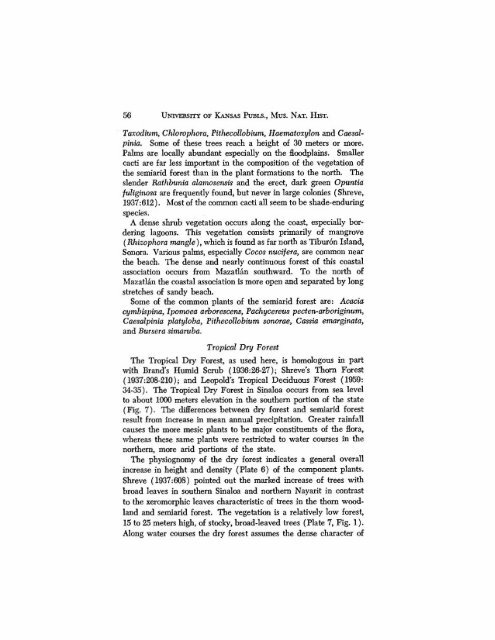The Amphibians and Reptiles of Sinaloa, Mexico - Smithsonian ...
The Amphibians and Reptiles of Sinaloa, Mexico - Smithsonian ...
The Amphibians and Reptiles of Sinaloa, Mexico - Smithsonian ...
You also want an ePaper? Increase the reach of your titles
YUMPU automatically turns print PDFs into web optimized ePapers that Google loves.
56 UNIVERSITY OF KANSAS PUBLS., MUS. NAT. HIST.<br />
Taxodium, Chlorophora, Pithecollobium, Haematoxylon <strong>and</strong> Caesalpinia.<br />
Some <strong>of</strong> these trees reach a height <strong>of</strong> 30 meters or more.<br />
Palms are locally abundant especially on the floodplains. Smaller<br />
cacti are far less important in the composition <strong>of</strong> the vegetation <strong>of</strong><br />
the semi arid forest than in the plant formations to the north. <strong>The</strong><br />
slender Rathbunia alamosensis <strong>and</strong> the erect, dark green Opuntia<br />
fuliginosa are frequently found, but never in large colonies (Sbreve,<br />
1937:612). Most <strong>of</strong> the common cacti all seem to be shade-enduring<br />
species.<br />
A dense shrub vegetation occurs along the coast, especially bordering<br />
lagoons. This vegetation consists primarily <strong>of</strong> mangrove<br />
{Rhizophora mangle), which is found as far north as Tiburon Isl<strong>and</strong>,<br />
Sonora. Various palms, especially Cocos nucifera, are common near<br />
the beach. <strong>The</strong> dense <strong>and</strong> nearly continuous forest <strong>of</strong> this coastal<br />
association occurs from Mazatlan southward. To the north <strong>of</strong><br />
Mazatlan the coastal association is more open <strong>and</strong> separated by long<br />
stretches <strong>of</strong> s<strong>and</strong>y beach.<br />
Some <strong>of</strong> the common plants <strong>of</strong> the semiarid forest are: Acacia<br />
cymbispina, Ipomoea arborescens, Pachycereus pecten-arboriginum,<br />
Caesalpima platyloba, Pitkecollobium sonorae> Cassia emarginata,<br />
<strong>and</strong> Bursera simaruba.<br />
Tropical Dry Forest<br />
<strong>The</strong> Tropical Dry Forest, as used here, is homologous in part<br />
with Br<strong>and</strong>'s Humid Scrub (1936:26-27); Shreve's Thorn Forest<br />
(1937:208-210); <strong>and</strong> Leopold's Tropical Deciduous Forest (1959:<br />
34-35). <strong>The</strong> Tropical Dry Forest in <strong>Sinaloa</strong> occurs from sea level<br />
to about 1000 meters elevation in the southern portion <strong>of</strong> the state<br />
(Fig. 7). <strong>The</strong> differences between dry forest <strong>and</strong> semiarid forest<br />
result from increase in mean annual precipitation. Greater rainfall<br />
causes the more mesic plants to be major constituents <strong>of</strong> the flora,<br />
whereas these same plants were restricted to water courses in the<br />
northern, more arid portions <strong>of</strong> the state.<br />
<strong>The</strong> physiognomy <strong>of</strong> the dry forest indicates a general overall<br />
increase in height <strong>and</strong> density (Plate 6) <strong>of</strong> the component plants.<br />
Shreve (1937:608) pointed out the marked increase <strong>of</strong> trees with<br />
broad leaves in southern <strong>Sinaloa</strong> <strong>and</strong> northern Nayarit in contrast<br />
to the xeromorphic leaves characteristic <strong>of</strong> trees in the thorn woodl<strong>and</strong><br />
<strong>and</strong> semiarid forest. <strong>The</strong> vegetation is a relatively low forest,<br />
15 to 25 meters high, <strong>of</strong> stocky, broad-leaved trees (Plate 7, Fig. 1).<br />
Along water courses the dry forest assumes the dense character <strong>of</strong>
















